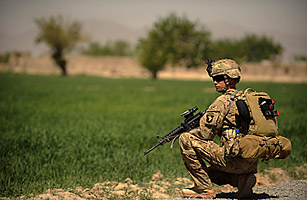
A little over a year ago, Kandahar province, like much of southern Afghanistan, was overwhelmed with Taliban fighters and underpatrolled by NATO troops. U.S. forces pushed into areas under Taliban control and in the summer and fall fought bloody battles to hold key approaches to Kandahar city. With the return of spring, the traditional start of the fighting season when the Taliban return from sanctuaries in Pakistan, Kandahar will be a crucial barometer to measure the success of the 2010 troop surge.
During the winter, soldiers from the 1st “Raider” Brigade, 4th Infantry Division, used the lull in fighting to conduct missions at the heart of a counterinsurgency strategy. American and NATO troops operated out of tiny outposts in the heart of the Kandahar countryside where they patrolled mostly on foot, learning about the terrain and the local citizens. They worked daily with Afghan soldiers and policemen, training, developing and sometimes goading them into taking more responsibility for local security.
The architect of the past year’s operations is Colonel Jeffrey Martindale, a compact, soft-spoken veteran of the Army’s elite 75th Ranger Regiment who commanded a battalion during Iraq’s bloody 2006 sectarian fighting. Martindale took command of the Raider brigade in late 2009 after the unit had spent the better part of the decade training for heavy armored maneuvers in between three tours in Iraq. Martindale designed training to focus more on light infantry maneuvers and a decentralized structure necessary for Afghanistan’s rugged terrain. “That’s paid off a lot here,” Martindale says. “We have to fight decentralized. Every village is different from the next.”
The structure allowed Martindale’s junior commanders to adjust their units to the upcoming fight. Lieut. Colonel Clay Padgett, the commander of the 1-22 Infantry, one of Martindale’s battalions, knew that more foot patrols would mean less time in vehicles and that units living on tiny outposts needed the ability to fire mortars rapidly. So Padgett trained his vehicle mechanics in basic mortar firing, which freed up his mortar platoon to conduct regular combat patrols. The troops in 1-22’s mortar platoon, who are all qualified infantrymen, have been patrolling a crucial area called Malajat since last fall.
On a frigid January morning, Staff Sergeant Ian Strickland led half of the mortar platoon from a tiny outpost before sunrise and marched to the far end of Malajat. The soldiers combed pomegranate orchards with metal detectors looking for hidden weapons caches. Strickland’s men have found dozens of caches since the last fighting season ended in November, which he hopes will degrade the Taliban’s ability to move and fight this spring.
Searching the orchards is an arduously slow and exhausting process. Every time the metal detector goes off, the troops have to dig. But after 30 years of fighting, the ground is littered with old Soviet mortar fragments and shards of metal that set off the detector. By January, the soldiers were barely registering surprise at the metal detector’s piercing squawk, digging until they ensured an area was clear before moving on through the field. “It’s really frustrating to get your hopes up and come up empty,” Strickland said as he stuffed a fresh wad of snuff into his lip. “But judging by what we’ve found, we’re bound to find more caches.”
On the hike back to the outpost on that day in January, Strickland spotted an old man he hadn’t seen before. He called for his interpreter, a young man from Kabul dressed in gray army-fatigue pants, white designer sneakers and a shiny leather jacket. Strickland squatted down and talked to the man for 15 minutes. It’s a key part of the counterinsurgency operation: getting to know every local resident so that when the insurgents return, the soldiers know who they should be fighting. “Over these winter months, we’ve learned this terrain so well,” Sergeant Zach Carpenter, one of the mortar-squad leaders, explained. “We know who’s supposed to be here and who isn’t, so if anyone comes around we don’t know, we check them out.” Carpenter, a tall, lean bull of a soldier with a prominent chin who walked point on nearly every patrol, was optimistic that their efforts would pay off in the spring. “The American people and government want it like,” he said, snapping his fingers, “but it’s slow. Progress is slow.”
See pictures of Afghanistan’s dangerous Korengal Valley.
See pictures of the battle against the Taliban.